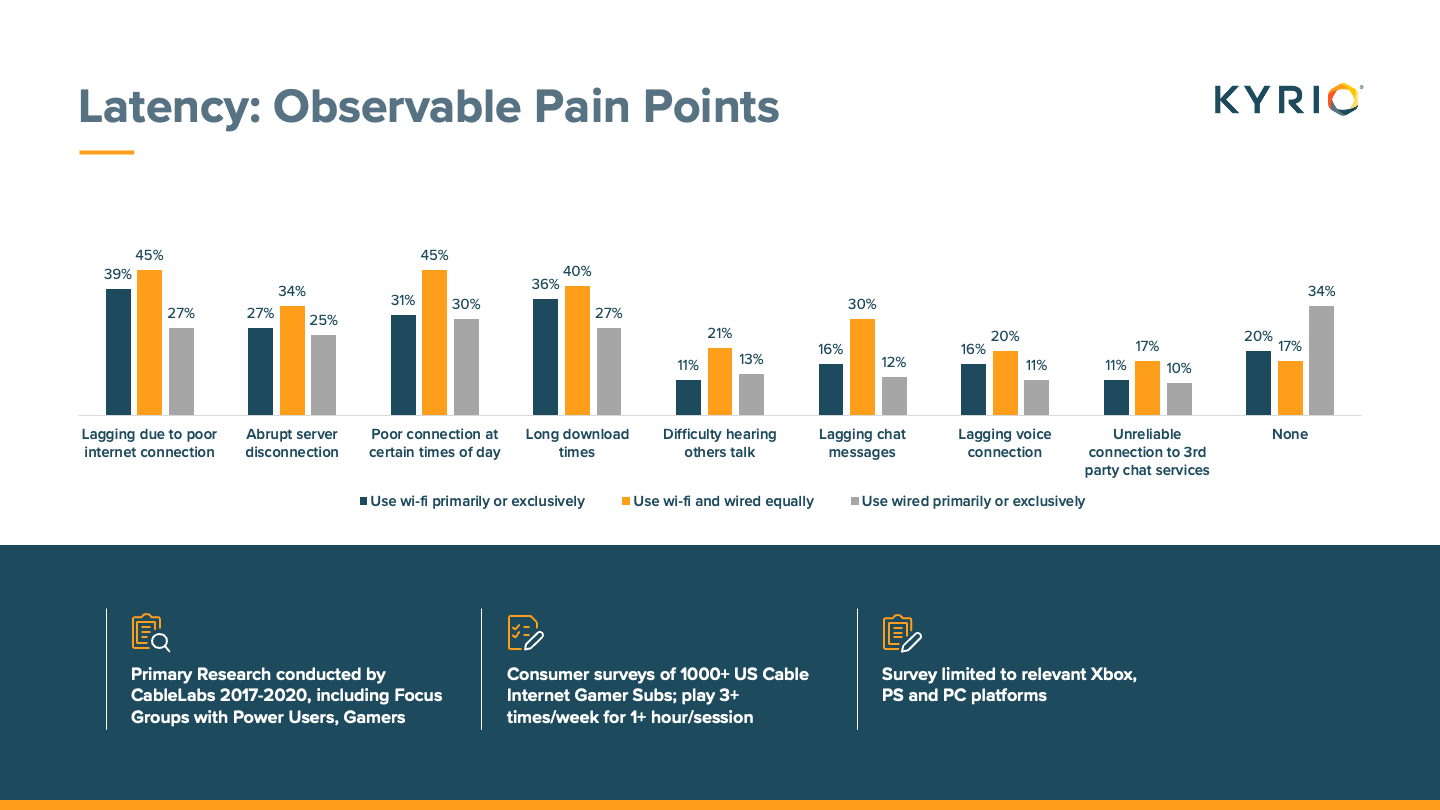Smart offices. Online gaming. Virtual reality. Today’s Wi-Fi and network applications must deliver seamless, quality user experiences that extend beyond speed alone. Traditionally, operators have relied on throughput values to measure network performance. But throughput can’t tell us much about what users actually experience when they interact with an application. Latency is a different category of KPI that factors in customer expectations and perceptions as they stream videos, play online games, and interact with IoT or VR scenarios.
In this webinar, Annie George, Kyrio’s Director of Wireless, explores the power of low latency as it relates to quality of experience and service. Along with guest speakers Sebnam Ozer, Principal Architect at Charter Communications, and David Dickson, Core Manager at Liberty Latin America, Annie examines the importance of low latency for Wi-Fi network performance in terms of user experience, productivity, and quality.
Latency Impacts Almost Every Aspect of User Experience
Latency is more reliable than speed in determining whether or not a customer will be happy with an application, because it factors in realistic performance. In focus groups and surveys conducted by CableLabs, users identified key pain points when using wireless products or applications, including lag time, server disconnections, long download times, lagging chat messages and more. These observable pain points are all related to latency issues, and addressing them will require a deeper look at latency problems and solutions.

That’s exactly why latency testing is critical for the wireless ecosystem, and it’s already a priority for many solution providers.
Charter Communications: Consistent Performance Is Key
Operators already recognize the urgency of improved latency performance, and many are working on solutions to address the inherent challenges. Among these is Charter Communications, which is focused on creating consistent latency to improve the user experience.
Sebnam Ozer shared four key ideas that serve as the foundation for Charter’s approach:
- We need consistent E2E latency for a superior user experience.
- More bandwidth does not guarantee consistent low latency and jitter.
- Active queue management with congestion notification is key for the success of low latency applications.
- Latency management should be conducted within the time window of Wi-Fi network and traffic fluctuations.
“Increasing speed alone is not enough for good quality of service that will lead to better quality of experience,” said Sebnam. “Not all factors are speed related. We are working to support emerging applications and preparing our system by working in the standards team to understand latency and how we can improve the quality of service features.”
Liberty Latin America (LLA): Advantages of Low Latency
As operators work to create a consistent user experience, they must also analyze how different application requirements affect latency priorities. David Dickson of Liberty Latin America explored these priorities as well as the advantages of low latency for user experience overall.
“Acceptable latency ranges vary not only network by network, but also application by application”, said David. For example, an email application where instantaneous response is not as critical will be able to function at higher latency ranges than a video streaming or gaming application. Network administrators can consider these priorities to allocate bandwidth appropriately and maintain seamless user experiences.
As low latency takes priority in overall user experience, users will benefit in several ways, including:
- Improved responsiveness
- Enhanced gaming experiences
- Seamless video streaming
- Improved business efficiency
- Better IoT device connectivity
- Performance of critical applications
These benefits will enhance experiences in a broad range of industries, from enterprise and education scenarios to healthcare and government.
How Kyrio Testing Diagnoses Latency Issues at Every Stage
Speed alone is just a small aspect of application performance. Today’s user experience KPIs must extend beyond throughput and speed to include the overall way people interact with and perceive an application. To achieve this, operators must consider latency and throughput values, understand loading and application performance, and optimize product design for real-world traffic scenarios. Ultimately, consistent performance is the foundation for positive consumer perceptions of a product.
Kyrio helps operators and suppliers diagnose critical latency issues by capturing performance data at all stages of product development both pre- and post-launch. Our internally-developed latency testing framework delivers:
- A Standardized, Neutral Testing Environment – Kyrio’s test labs are controlled and consistent to specific variables like radio frequency and traffic profiles.
- The Right Prioritization of Traffic – Differentiated services code points (DSCP) apply multiple WMM access labels to prioritize traffic.
- Variety of Traffic Models – We capture and predict variations on performance using real-world traffic models.
- Actionable Insights – We capture latency and its associated KPIs, throughput, airtime fairness, packet loss, and performance under loaded conditions.
“Kyrio’s testing approach provides more realistic data by reflecting traffic patterns and application usage in the real world,” said Annie. “The advantage of working with Kyrio is that we work on all aspects of Wi-Fi and the results you get from us can be compared with other testing scenarios to see how the data correlates.”
Ready to learn more about the challenges and opportunities of low latency? Watch the full webinar to examine the importance of low latency for user experience in Wi-Fi networks, understand effective latency testing methodologies, and uncover the benefits for both users and enterprises.











